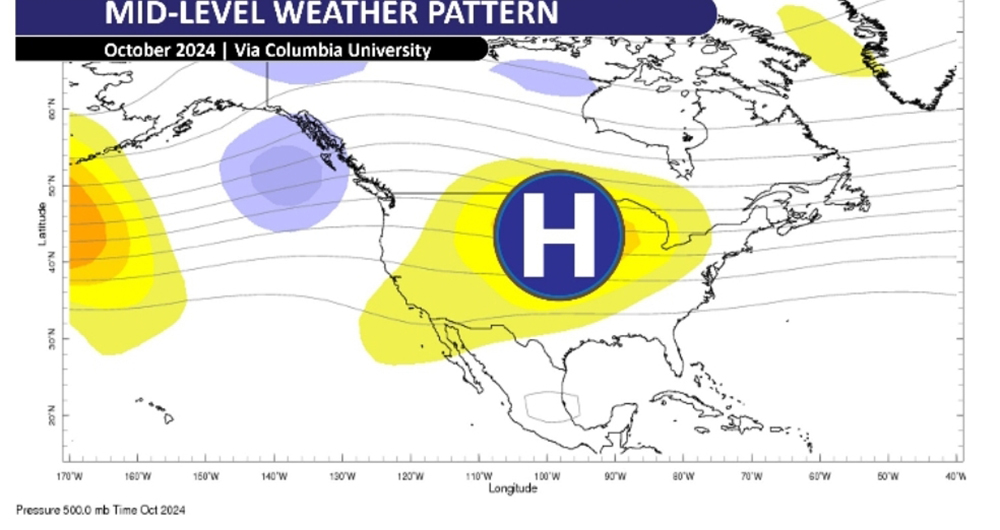By Meteorologist Joe Martucci
In the Book of Genesis, God warns Noah of an epic downpour – 40 days and 40 nights of relentless rain.
New Jersey just lived through the flip side: 40 parched, bone-dry days. It wasn’t until Sunday night (Nov. 10) that the heavens finally cracked open, ending the state’s longest dry streak on record.
While Noah and his animals waited for the flood to recede, New Jerseyans eagerly waited for those first drops of rain to break the dry stretch.
Atlantic City International Airport went 38 days in a row without measurable rainfall, from Oct. 3 to Nov. 9. The Sen. Frank S. Farley State Marina in Atlantic City tied its record with a streak of 39 days, running from Oct. 2 to Nov. 9.
Both matched and broke the previous longest marks set in 1995. Back then, ACY Airport went through a 34-day stretch from Aug. 13 to Sept. 15. Atlantic City itself tied the record from Aug. 8 to Sept. 15.
Setting an all-time weather record is impressive. Relatively speaking, though, the South Jersey shore was less impressive than other areas of New Jersey.
Through Nov. 9, Long Branch in Monmouth County went 41 days in a row dry. Our state capital in Trenton went 42 days in a row dry, besting the previous mark set in 1903.

Average weather pattern for the month of October, about 18,000 feet high, roughly where the 500 millibar air pressure layer lies. This is a valuable tool meteorologists use to study past, current and future weather events. (Columbia University)
All major weather reporting stations in the state set records during this incredible dry stretch. We tried to rain twice – Nov. 1 as well as Oct. 24. However, measurable rain did not fall. Rather, a trace of rain – an unmeasurable amount was all we got (think of a few raindrops on a windshield).
The consistent dry weather was great for outdoor sports, events and even a few late-season beach days (I was out there on Halloween). However, it brought many negative impacts.
Atlantic County, as well as southern Ocean County and eastern Burlington county, are in their most severe drought since 2002, according to the United States Drought Monitor’s Nov. 7 update. All of New Jersey is in drought, too. Voluntary water restrictions are in place statewide.
Lack of rain made conditions ideal for numerous wildfires in the state. Thankfully, they were all small. For the South Jersey shore, no wildfires sparked up near us. It prompted what was likely the latest-in-the-year red flag warnings on record for high fire danger by the New Jersey Forest Fire Service last week.
On the plus side. WCBS-TV reported that cranberry farmers say this year’s crop is the best in years. The lack of rain made Jersey’s specialty super sweet and without the fungi that can impact the fruit during the fall.
There are four reasons why this record dry streak called the Jersey Shore home these past few weeks.
Westward expansion of the Bermuda high pressure
High pressure pushes air from the top of the atmosphere down to the surface and out. In other words, it usually keeps the rain away when you’re within its influence. During the summer, Bermuda high pressure stays in a semi-permanent state over the island country. The clockwise winds bring us hazy, hot and humid weather from the southwest.
But this year the high pressure poked itself a little farther west than usual. That acted like a shield, keeping the storms to our south, west and north. It’s why Hurricane Helene didn’t bring us the devastating rains that North Carolina, Tennessee and more had. In fact, if you look at rainfall totals over the past 40 days, you’ll see a clockwise swirl of heavy accumulated rain from the South into the Midwest and then in southeastern Canada.
Northwesterly winds aloft
Winds 10,000 to 20,000 feet aloft were generally out of the northwest direction. Just like northwest winds that we feel at the surface, it generally brings in a drier air mass.
During October, a ridge of high pressure aloft averaged to a position in the Upper Midwest. That clockwise spinning motion of the high meant winds out of the northwest for us.
Human-caused climate change
In a climate changing world, the Earth has and will see longer stretches of dry and wet weather. In our case, it was the dry weather that held on.
The northwesterly winds aloft and the westward expansion of the Bermuda high pressure all generally stayed locked into place over this dry spell. Stalled weather patterns like this have become more common, according to the National Aeronautics and Space Administration.
Lack of tropical moisture
The lack of tropical moisture is related to the first three reasons, but deserves its own spot. As New Jersey State Climatologist Dave Robinson noted in our Monthly Weather Roundup video (you can find it on my YouTube channel), rain from dying tropical storms and hurricanes is an important part of our weather during the fall. We simply didn’t have that this season.
This tropical moisture is so important because there are few other ways for rain to come down during fall at the Jersey Shore. The nor’easter season doesn’t really get going until Thanksgiving time. Also, we’re past the time for pop-up thunderstorms to drop a quick inch or two of rain.
That just leaves us at the whim of cold fronts bringing rain. However, the cold fronts, which mainly came from the northwest, originated from a drier air mass. There wasn’t really any unstable air in the atmosphere to spark up thunderstorms on the front, and no warm fronts with rain passed, either.
In closing
To be honest, this will likely be the longest dry streak you’ll ever experience in New Jersey. Even if you snowbird to “sunny” Florida for the winter, you’re unlikely to encounter a dry streak like the one we just had. This is more like the Desert Southwest – Phoenix, Las Vegas or even San Diego.
The rain this past Sunday night is not a sign of a wetter pattern to come, though. The Climate Prediction Center, a government forecast agency based in College Park, Md., is not forecasting above-average precipitation for the rest of the month. So, our drought will continue to get worse before it gets better.
Joe earned his Meteorology Degree from Rutgers University. He is approved by the American Meteorological Society as a Certified Broadcast Meteorologist and Certified Digital Meteorologist, the only one in the state with both. He’s won 10 New Jersey Press Association Awards. You can find him on social media @joemartwx











